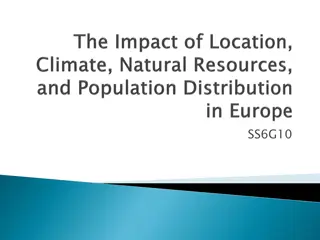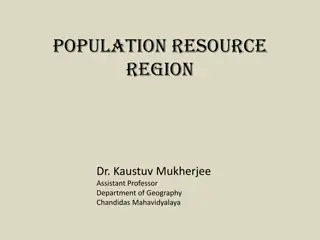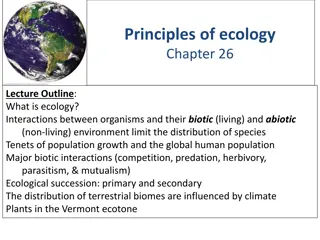Impact of Location, Climate, and Resources on Population Distribution in Canada
Canada's diverse geography, from cold Arctic regions to fertile farmlands, influences where people live and how they make a living. The distribution of natural resources like mineral deposits and the temperate climate play key roles in shaping population distribution and trade patterns in the country.
Download Presentation

Please find below an Image/Link to download the presentation.
The content on the website is provided AS IS for your information and personal use only. It may not be sold, licensed, or shared on other websites without obtaining consent from the author. Download presentation by click this link. If you encounter any issues during the download, it is possible that the publisher has removed the file from their server.
E N D
Presentation Transcript
SS6G6: The student will explain the impact of location, climate, distribution of natural resources, and population distribution in Canada. A. Describe how Canada s location, climate, and natural resources have affected where people live. B. Describe how Canada s location, climate, and natural resources impact trade.
Much of Canada has a very cold climate. Canadians live where the temperatures are comfortable and natural resources are available to help make a good living. About 75% of Canadians live in the cities and towns of southern Canada.
In the western Pacific Mountain region, the climate varies from snow and ice in the mountains to mild, rainy weather along the coast. The rolling western plains are rich farmlands and many crops are grown there.
Rocky land throughout the Canadian Shield is not fit for farming but contains many mineral deposits. Mining is an important occupation there.
The Great Lakes/St. Lawrence River Lowlands is the most densely populated part of Canada. People live there because of its fertile land, temperate climate, and large cities like Montreal and Toronto.
Fishermen make a living along both coastlines. Eskimos are the few inhabitants of the frigid Arctic Islands.
Although Canada is a massive country, most Canadians live within 200 miles of the United States border!
1. Most Canadians live in __________ Canada. 2. The western plains contain rolling plains and rich _________. 3. __________ deposits are found in the Canadian Shield. 4. Name two cities located in the Great Lakes/ St. Lawrence River Lowlands. 5. List three reasons why so many people live in the Great Lakes/St. Lawrence Rive area.
Canadas trade is impacted by its location, climate, and natural resources. Its location determines its major trading partner, and its climate and natural resources determine what Canada trades.
Canada exports many of its natural resources to other countries. Fishing is a very important industry on both coasts, supported by fertile fishing waters. Massive forests stretch across Canada, providing lumber and pulp (softened wood fibers) to make paper.
Wheat grown in the plains has made Canada one of the world s major producers of this important product. The Canadian Shield provides nickel, copper, gold, silver, zinc, and uranium. Oil and natural gas are mainly found in the western plains area.
About 70% of Canadas manufactured goods are produced in the Great Lakes region, where the lakes, rivers, and St. Lawrence Seaway are used to transport goods to other countries.
The U.S. is Canadas major trading partner because of their shared border. Most of Canada s imports come from the U.S., and most of its exports go to the U.S.
1. What industry is supported by oceans on either side of Canada? 2. What Canadian natural resource is needed to make paper? 3. What important product is grown on Canada s plains? 4. List six minerals exported by Canada. 5. Manufactured goods are easily transported by the lakes, rivers and ________ in the Great Lakes area. 6. What country is Canada s major trading partner?























